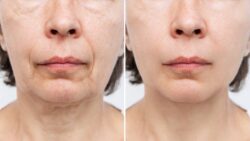
What Is a Facelift? (Rhytidectomy)
A facelift, medically known as rhytidectomy, is a surgical procedure designed to reduce the visible signs of aging in the face and neck. This popular cosmetic surgery aims to lift and tighten sagging skin, smooth out wrinkles, and rejuvenate the overall appearance of the face. It can help individuals restore a more youthful appearance, combating the natural effects of aging, sun damage, and gravity. In this blog, we’ll cover everything you need to know about facelifts—from the procedure itself to potential risks, recovery, and alternatives.
What Is a Facelift?
A facelift is a cosmetic surgery that targets the facial skin, muscles, and underlying tissues to lift and tighten the skin. The goal is to improve the appearance of sagging skin around the face, jawline, and neck, making a person look younger. During a facelift, a surgeon typically removes excess skin, tightens the underlying muscles, and smooths out wrinkles, resulting in a more youthful and refreshed appearance.
Facelifts can address various signs of aging, such as drooping cheeks, jowls, and loose skin around the neck. While the procedure doesn’t stop the aging process, it can significantly delay the visible effects of aging by restoring facial contours.
Why Do People Get Facelifts?
Facelifts are often chosen by individuals who want to reduce visible signs of aging and enhance their appearance. Common reasons why people choose to undergo a facelift include:
- Drooping skin around the cheeks, jawline, and neck
- Deep facial wrinkles or creases, particularly around the nose and mouth
- Loss of skin elasticity and facial volume
- Sagging jowls or a double chin
- A desire for a more youthful appearance without drastic changes
Facelifts are not only about aesthetics but also about restoring a person’s confidence and self-esteem. It’s important to note that while a facelift can rejuvenate the face, it doesn’t change a person’s fundamental appearance or make them look drastically different from who they are.

Different Types of Facelifts
There are various types of facelifts, each tailored to specific needs and concerns. Some of the most common types include:
-
Traditional Facelift
A traditional facelift is the most comprehensive type of facelift, where a surgeon makes incisions along the hairline and around the ears. This allows access to the deeper layers of skin and tissue to tighten and lift the face and neck.
-
Mini Facelift
A mini facelift is a less invasive version of a traditional facelift. It involves smaller incisions and focuses on lifting the lower portion of the face, especially the jowls and neck area. This option is ideal for patients with mild to moderate signs of aging.
-
Mid-Facelift
A mid-facelift targets the middle of the face, including the cheeks and under-eye area. It is a good option for individuals who want to address sagging in the cheek region but don’t require a full facelift.
-
Thread Lift
A thread lift is a non-surgical alternative that uses special threads to lift and tighten the skin. It is minimally invasive, offers quicker recovery, and is best for individuals who only need a subtle lift or are not yet ready for a full facelift.
-
Neck Lift
A neck lift is a targeted procedure aimed specifically at the neck area. It focuses on removing excess skin, tightening the underlying muscles, and smoothing out wrinkles, helping to restore a more youthful neckline.
How Is a Facelift Performed?
A facelift is typically performed under general anesthesia or local anesthesia with sedation. The exact steps depend on the type of facelift being performed, but generally, the procedure follows these stages:
-
Consultation and Planning
During your initial consultation, your surgeon will assess your facial structure, discuss your goals, and recommend the most suitable type of facelift for your needs.
-
Incision Placement
In a traditional facelift, the surgeon will make an incision near the hairline, around the ears, and sometimes under the chin to access the underlying muscles and tissue.
-
Tightening and Lifting
The surgeon will tighten the underlying muscles and tissue before removing excess skin. This process lifts the face and smooths out wrinkles.
-
Skin Redraping
After the muscles and tissues are tightened, the surgeon will redrape the skin over the newly contoured face. Any excess skin will be trimmed.
-
Closing the Incisions
Once the facelift is complete, the surgeon will close the incisions with stitches, which are carefully placed to minimize visible scarring.

Recovery After a Facelift
Recovery time varies depending on the extent of the procedure. Generally, after a facelift, you can expect the following:
-
Immediate Aftercare
After the surgery, you will be monitored for a short period, and your surgeon will provide specific instructions on how to care for your face. This may include taking prescribed pain medications, using cold compresses, and keeping your head elevated to reduce swelling.
-
Swelling and Bruising
Swelling and bruising are common after a facelift and can last for several weeks. Most people can return to work and daily activities within two to four weeks, though some individuals may take longer to fully recover.
-
Post-Operative Appointments
Follow-up appointments will be scheduled to ensure the healing process is progressing properly. During these visits, your surgeon will remove any stitches and check for complications.
-
Full Recovery
It may take several months for the full effects of the facelift to be visible, as swelling gradually subsides and the skin settles into its new position. Scars will fade over time but may not completely disappear.
Risks and Complications of a Facelift
Like any surgical procedure, facelifts carry certain risks. Some potential complications include:
- Infection: Any surgical procedure carries the risk of infection, which can cause redness, swelling, or discharge at the incision sites.
- Scarring: While facelifts are designed to minimize visible scarring, some scarring is inevitable. Scars are usually well-hidden in natural facial folds and the hairline.
- Asymmetry: In rare cases, the results may not be perfectly symmetrical. Some patients may require additional procedures to correct unevenness.
- Nerve Damage: Temporary or permanent nerve damage can occur in rare cases, affecting the facial muscles or sensation.
Choosing a qualified and experienced surgeon significantly reduces the likelihood of complications.
Facelift Before & After Images

Cost of a Facelift
The cost of a facelift varies widely depending on factors such as the surgeon’s expertise, the type of facelift performed, geographical location, and the extent of the procedure. On average, facelifts in the U.S. can range from $7,000 to $15,000, though the price may be higher if additional procedures are needed. Since facelifts are considered cosmetic surgery, they are typically not covered by insurance.
Alternatives to a Facelift
If you’re not ready for a full facelift or prefer non-surgical options, there are several alternatives available:
- Botox and Fillers: Injectable treatments can smooth wrinkles and restore volume to the face, providing a temporary solution to aging signs.
- Laser Skin Resurfacing: This non-invasive procedure uses laser technology to improve skin texture, reduce wrinkles, and address age spots.
- Ultherapy: This non-surgical treatment uses ultrasound energy to lift and tighten the skin, offering a subtle facelift effect without surgery.
Who Is a Good Candidate for a Facelift?
Ideal candidates for a facelift are generally individuals in good health who are looking for a long-term solution to sagging skin and wrinkles. The best candidates:
- Are typically between 40 and 70 years old, although age is not the only determining factor.
- Have realistic expectations about the outcomes and understand the limitations of the procedure.
- Are not smokers, as smoking can impair healing and increase the risk of complications.
- Have sufficient skin elasticity to achieve desirable results.

FAQs About Facelift
How long do the results of a facelift last?
Facelift results typically last anywhere from 7 to 10 years, depending on factors such as the patient’s age, skin type, lifestyle, and how well they take care of their skin after the procedure.
Can I combine a facelift with other procedures?
Yes, many patients choose to combine facelifts with other cosmetic procedures such as eyelid surgery (blepharoplasty), brow lifts, or liposuction to achieve more comprehensive facial rejuvenation.
What is the difference between a facelift and a neck lift?
While both surgeries target aging signs, a neck lift specifically addresses the neck area by tightening the skin and muscles, while a facelift focuses on the lower face and upper neck.
Will a facelift make me look unnatural or “overdone”?
A skilled surgeon aims for natural results by restoring youthful contours while maintaining the individual’s unique facial features. An experienced surgeon will avoid overly tight or “frozen” looks.
Is there any way to speed up the recovery process after a facelift?
Following post-surgery instructions carefully, such as avoiding strenuous activities, keeping your head elevated, using prescribed medications, and attending follow-up appointments, can help speed up recovery.
Can a facelift fix deep facial lines or wrinkles around the eyes and mouth?
While a facelift primarily targets sagging skin, it can improve the overall appearance of facial lines. However, for deeper lines around the eyes or mouth, additional treatments like Botox, dermal fill
ers, or laser resurfacing might be recommended.
What is the best age to get a facelift?
Most patients undergo facelifts between their 40s and 60s, but the best age for a facelift depends on an individual’s skin condition and personal aging concerns.
Can I get a facelift if I have a history of smoking?
Smoking can interfere with the healing process and increase the risk of complications. If you smoke, it’s important to quit several weeks before the surgery and follow your surgeon’s advice for a successful recovery.
Are facelifts safe for individuals with existing medical conditions?
Patients with certain medical conditions (such as heart disease or diabetes) may need to undergo a thorough evaluation before proceeding with a facelift. It’s essential to consult with your doctor and surgeon to ensure it’s safe for you.
What happens if I’m not happy with the results of my facelift?
If you are dissatisfied with the results, consult your surgeon as soon as possible. In some cases, revisions can be made after the swelling has subsided, usually after several months. It’s important to have realistic expectations and clear communication with your surgeon.
Is a Facelift Right for You?
A facelift can be an effective way to restore a youthful appearance and boost confidence. If you’re bothered by sagging skin, wrinkles, and jowls, and you have realistic expectations, a facelift might be a great option for you. It’s essential to consult with a board-certified surgeon to determine the best approach for your goals and ensure that you’re a suitable candidate for the procedure.
Remember, facelifts are not a one-size-fits-all solution, and the decision to undergo surgery should be made carefully. With the right surgeon and proper post-operative care, a facelift can deliver natural, long-lasting results that help you look and feel your best.
